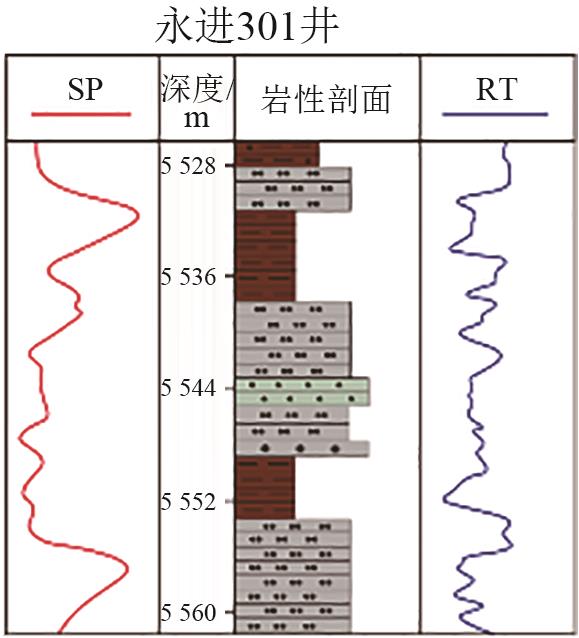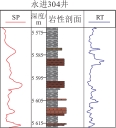

Oil & Gas Geology ›› 2024, Vol. 45 ›› Issue (5): 1275-1288.doi: 10.11743/ogg20240506
• Petroleum Geology • Previous Articles Next Articles
Fan SONG1( ), Qingyuan KONG1, Xuecai ZHANG2, Haifang CAO2, Guohua JIAO3, Yue YANG1
), Qingyuan KONG1, Xuecai ZHANG2, Haifang CAO2, Guohua JIAO3, Yue YANG1
Received:2024-03-18
Revised:2024-07-17
Online:2024-10-30
Published:2024-11-06
CLC Number:
Fan SONG, Qingyuan KONG, Xuecai ZHANG, Haifang CAO, Guohua JIAO, Yue YANG. Sedimentary characteristics and models of shallow-water deltas in arid settings: A case study of the Jurassic Qigu Formation in the Yongjin area within the hinterland of the Junggar Basin[J]. Oil & Gas Geology, 2024, 45(5): 1275-1288.
Add to citation manager EndNote|Reference Manager|ProCite|BibTeX|RefWorks
Table 1
Lithofacies types and distributions in the J3q in the Yongjin area, Junggar Basin"
| 岩相类型 | 分布特征 | ||
|---|---|---|---|
| 大类 | 小类 | ||
| 砾岩相 | 顺层定向排列中-细砾岩相 | 分布于正韵律底部冲刷面附近 | |
| 杂乱分布细砾岩相 | 分布于单层底部,侵蚀下部泥岩 | ||
| 砂岩相 | 平行层理中-粗砂岩相 | 砂岩中最常见的岩相类型 | |
| 板状交错层理中-细砂岩相 | 偶见于正韵律砂体上部 | ||
| 冲刷侵蚀中-细砂岩相 | 常见于单期正韵律下部 | ||
| 块状构造细砂岩相 | 红褐色砂岩中常见,泥质含量高 | ||
| 富生物扰动块状细砂岩相 | 见于南部、东部红褐色砂岩之中 | ||
| 富泥砾中-粗砂岩相 | 偶见于正韵律砂体底部 | ||
| 粉砂岩相 | 平行层理粉砂岩相 | 见于薄砂层顶部,可见顺层泥砾 | |
| 楔状交错层理粉砂岩相 | 见于粉砂岩变为泥岩的界面处 | ||
| 波状层理粉砂岩相 | 常见于粉砂岩夹层之中 | ||
| 软沉积变形粉砂岩相 | 偶见于粉砂岩夹层之中 | ||
| 泥岩相 | 红褐色块状泥岩相 | 常见于齐古组上部厚层稳定泥岩 | |
| 灰色夹粉砂质条带泥岩相 | 常见于厚层砂岩中的泥质隔夹层 | ||
Table 2
Characteristics of various sedimentary microfacies in the J3q in the Yongjin area, Junggar Basin"
| 沉积微相类型 | 岩性特征 | 主要岩相类型 | 水动力 | 地形位置 | 沉积构造 | 分布样式 | 测井响应 |
|---|---|---|---|---|---|---|---|
高能水下 主干河道 | 砂砾岩、 含砾粗砂岩 | 中-细砾岩相、 中-粗砂岩相、 块状泥岩相 | 强 | 断槽、沟槽等 相对低部位 | 平行层理、 板状交错层理 | 长条形 定向分布 |  |
| 中-高能网状分流河道 | 中-细砂岩、 粉砂岩 | 中-细砂岩相、 细砂岩相、 块状泥岩相 | 较强 | 古地形相对 较高部位 | 平行层理、 小型交错层理 | 交织状 连片分布 |  |
低能改造型 分流河道 | 粉-细砂岩、 泥质粉砂岩 | 细砂岩相、 粉砂岩相、 块状泥岩相 | 较弱 | 古地形相对 较高部位 | 小型交错层理、 波状层理 | 席状 连片分布 |  |
| 分流间湾 | 泥岩 | 粉砂岩相、 块状泥岩相、 灰色泥岩相 | 弱 | 低部位 | 块状 | 局限分布 |  |
Table 3
Primary parameters for numerical simulations of the sedimentary process of the J3q reservoirs in the Yongjin area, Junggar Basin"
| 模拟参数 | 设定值 | 模拟参数 | 设定值 |
|---|---|---|---|
| 沉积物粒度中值 | 1.0 mm | 砂厚变化记录下限 | 0.2 m |
| 底床坡度 | 3.0° | 水体密度 | 1 000 kg/m3 |
| 砂/泥比 | 4∶1 | 河道规模(宽×深) | 600 m×2 m |
| 流量 | 1 500 m3/s | 重力加速度 | 9.8 m/s2 |
| 流速 | 0.8 ~ 1.5 m/s | 水平黏滞系数 | 0.001 m2/s |
| 网格单元大小 | 33 m×33 m | 模拟时间步长 | 0.2 min |
| 1 | 朱筱敏, 谈明轩, 董艳蕾, 等. 当今沉积学研究热点讨论——第20届国际沉积学大会评述[J]. 沉积学报, 2019, 37(1): 1-16. |
| ZHU Xiaomin, TAN Mingxuan, DONG Yanlei, et al. Current hot topics of sedimentology: Comment on the 20th International Sedimentological Congress[J]. Acta Sedimentologica Sinica, 2019, 37(1): 1-16. | |
| 2 | 张新涛, 周心怀, 李建平, 等. 敞流沉积环境中 “浅水三角洲前缘砂体体系” 研究[J]. 沉积学报, 2014, 32(2): 260-269. |
| ZHANG Xintao, ZHOU Xinhuai, LI Jianping, et al. Unconfined flow deposits in front sandbodies of shallow water deltaic distributary systems[J]. Acta Sedimentologica Sinica, 2014, 32(2): 260-269. | |
| 3 | 孙靖, 薛晶晶, 吴海生, 等. 远源、细粒型浅水三角洲沉积特征与演化——以准噶尔盆地腹部莫索湾地区八道湾组为例[J]. 沉积学报, 2016, 34(1): 129-136. |
| SUN Jing, XUE Jingjing, WU Haisheng, et al. Distal fine-grain shallow-water delta sedimentary characteristics and evolution: A case from Badaowan Formation in the central Junggar Basin[J]. Acta Sedimentologica Sinica, 2016, 34(1): 129-136. | |
| 4 | 杨帆, 曹正林, 卫延召, 等. 玛湖地区三叠系克拉玛依组浅水辫状河三角洲沉积特征[J]. 岩性油气藏, 2019, 31(1): 30-39. |
| YANG Fan, CAO Zhenglin, WEI Yanzhao, et al. Sedimentary characteristics of shallow-water braided delta of Karamay Formation in Mahu area[J]. Lithologic Reservoirs, 2019, 31(1): 30-39. | |
| 5 | 易晶晶, 陈科霏. 江汉盆地潜江凹陷盐湖浅水三角洲沉积特征与发育模式[J]. 西北地质, 2021, 54(4): 199-210. |
| YI Jingjing, CHEN Kefei. Sedimentary characteristics and development model of shallow-water delta of salt lake in Qianjiang Depression[J]. Northwestern Geology, 2021, 54(4): 199-210. | |
| 6 | 何庆斌, 张继红. 松辽盆地南部大安地区姚一段层序地层格架与浅水三角洲沉积特征及演化[J]. 大庆石油地质与开发, 2022, 41(6): 1-12. |
| HE Qingbin, ZHANG Jihong. Sedimentary characteristics and evolution of shallow-water delta in sequence stratigraphic framework of Member 1 of Yaojia Formation in Da’an area, South Songliao Basin[J]. Petroleum Geology & Oilfield Development in Daqing, 2022, 41(6): 1-12. | |
| 7 | 朱筱敏, 刘媛, 方庆, 等. 大型坳陷湖盆浅水三角洲形成条件和沉积模式: 以松辽盆地三肇凹陷扶余油层为例[J]. 地学前缘, 2012, 19(1): 89-99. |
| ZHU Xiaomin, LIU Yuan, FANG Qing, et al. Formation and sedimentary model of shallow delta in large-scale lake. Example from Cretaceous Quantou Formation in Sanzhao Sag, Songliao Basin[J]. Earth Science Frontiers, 2012, 19(1): 89-99. | |
| 8 | 徐振华, 吴胜和, 刘钊, 等. 浅水三角洲前缘指状砂坝构型特征——以渤海湾盆地渤海BZ25油田新近系明化镇组下段为例[J]. 石油勘探与开发, 2019, 46(2): 322-333. |
| XU Zhenhua, WU Shenghe, LIU Zhao, et al. Sandbody architecture of the bar finger within shoal water delta front: Insights from the Lower Member of Minghuazhen Formation, Neogene, Bohai BZ25 Oilfield, Bohai Bay Basin, East China[J]. Petroleum Exploration and Development, 2019, 46(2): 322-333. | |
| 9 | 刘诗奇, 朱筱敏, 王瑞, 等. 陆相湖盆浅水三角洲沉积体系研究[J]. 山东科技大学学报(自然科学版), 2012, 31(5): 93-104. |
| LIU Shiqi, ZHU Xiaomin, WANG Rui, et al. Study on sedimentary system of shallow delta in continental lake basin[J]. Journal of Shandong University of Science and Technology(Natural Science), 2012, 31(5): 93-104. | |
| 10 | 张昌民, 尹太举, 朱永进, 等. 浅水三角洲沉积模式[J]. 沉积学报, 2010, 28(5): 933-944. |
| ZHANG Changmin, YIN Taiju, ZHU Yongjin, et al. Shallow-water deltas and models[J]. Acta Sedimentologica Sinica, 2010, 28(5): 933-944. | |
| 11 | 王文涛. 河控浅水三角洲前缘砂体分布特征及沉积模式研究——以大庆油田杏六区东部SⅡ油层为例[D]. 大庆: 东北石油大学, 2018. |
| WANG Wentao. Research on sandbody distribution and sedimentary model in Shallow lacustrine fluvial-dominated delta front—A case study from SII oil layer in the eastern part of Xing six block of Daqing Oilfield[D]. Daqing: Northeast Petroleum University, 2018. | |
| 12 | 王夏斌, 姜在兴, 胡光义, 等. 浅水三角洲分流河道沉积模式分类[J]. 地球科学与环境学报, 2020, 42(5): 654-667. |
| WANG Xiabin, JIANG Zaixing, HU Guangyi, et al. Classification of sedimentary models of distributary channels in shallow-water deltas[J]. Journal of Earth Sciences and Environment, 2020, 42(5): 654-667. | |
| 13 | 蔡忠贤, 陈发景, 贾振远. 准噶尔盆地的类型和构造演化[J]. 地学前缘, 2000, 7(4): 431-440. |
| CAI Zhongxian, CHEN Fajing, JIA Zhenyuan. Types and tectonic evolution of Junggar Basin[J]. Earth Science Frontiers, 2000, 7(4): 431-440. | |
| 14 | 鲁雪松, 赵孟军, 陈竹新, 等. 准噶尔盆地南缘齐古油田油气成藏再认识及勘探启示[J]. 石油学报, 2019, 40(9): 1045-1058, 1115. |
| LU Xuesong, ZHAO Mengjun, CHEN Zhuxin, et al. Recognition of hydrocarbon accumulation in Qigu oilfield and implications for exploration in the southern margin of Junggar Basin[J]. Acta Petrolei Sinica, 2019, 40(9): 1045-1058, 1115. | |
| 15 | 何文军, 费李莹, 阿布力米提·依明, 等. 准噶尔盆地深层油气成藏条件与勘探潜力分析[J]. 地学前缘, 2019, 26(1): 189-201. |
| HE Wenjun, FEI Liying, YIMING Abulimiti, et al. Accumulation conditions of deep hydrocarbon and exploration potential analysis in Junggar Basin, NW China[J]. Earth Science Frontiers, 2019, 26(1): 189-201. | |
| 16 | 任新成. 准噶尔盆地永进油田西山窑组油藏成岩演化及成藏史[J]. 新疆石油地质, 2021, 42(1): 21-28. |
| REN Xincheng. Diagenetic evolution and hydrocarbon accumulation history in reservoirs of Xishanyao Formation in Yongjin Oilfield, Junggar Basin[J]. Xinjiang Petroleum Geology, 2021, 42(1): 21-28. | |
| 17 | 董臣强. 准噶尔盆地永进油田西山窑组储层形成机理研究[J]. 新疆地质, 2014, 32(1): 92-95. |
| DONG Chenqiang. The formation mechanism of reservior from Xishanyao Formation in Yongjin Oilfield, Tarim Basin[J]. Xinjiang Geology, 2014, 32(1): 92-95. | |
| 18 | 范媛媛. 新疆准噶尔盆地南缘上侏罗统齐古组沉积相及沉积环境研究[D]. 西安: 长安大学, 2021. |
| FAN Yuanyuan. A study on sedimentary facies and sedimentary environment of the Upper Jurassic Qigu Formation in the southern margin of Junggar Basin, Xinjiang[D]. Xi’an: Chang’an University, 2021. | |
| 19 | 唐勇,宋永,何文军,等.准噶尔叠合盆地复式油气成藏规律[J].石油与天然气地质,2022,43(1):132-148. |
| TANG Yong, SONG Yong, HE Wenjun, et al. Characteristics of composite hydrocarbon accumulation in a superimposed basin, Junggar Basin[J]. Oil & Gas Geology, 2022, 43(1): 132-148. | |
| 20 | 修金磊, 王晓, 刘胜涛, 等. 准噶尔盆地永进地区西山窑组储层特征及影响因素[J]. 石油地质与工程, 2015, 29(3): 28-30. |
| XIU Jinlei, WANG Xiao, LIU Shengtao, et al. Reservoir characteristics and influencing factors analysis of Xishanyao Formation in Yongjin area, Junggar Basin[J]. Petroleum Geology and Engineering, 2015, 29(3): 28-30. | |
| 21 | 朱珍君, 李琦, 李剑, 等. 准噶尔盆地莫西庄—永进地区白垩系清水河组地貌演化及沉积响应[J]. 现代地质, 2022, 36(1): 105-117. |
| ZHU Zhenjun, LI Qi, LI Jian, et al. Geomorphic evolution and sedimentary response of Cretaceous Qingshuihe Formation in Moxizhuang-Yongjin area, Junggar Basin[J]. Geoscience, 2022, 36(1): 105-117. | |
| 22 | 郑丹. 准噶尔盆地莫西庄-永进地区油气成藏差异分析[J]. 石油地质与工程, 2022, 36(3): 33-39. |
| ZHENG Dan. Difference analysis of oil and gas accumulation in Moxizhuang-Yongjin area of Junggar Basin[J]. Petroleum Geology and Engineering, 2022, 36(3): 33-39. | |
| 23 | 丁咸宝, 沈扬, 赵永福, 等. 准噶尔盆地永进地区侏罗系红层成因[J]. 油气地质与采收率, 2009, 16(4): 12-14. |
| DING Xianbao, SHEN Yang, ZHAO Yongfu, et al. Genesis of Jurassic red beds in Yongjin area, Junggar Basin[J]. Petroleum Geology and Recovery Efficiency, 2009, 16(4): 12-14. | |
| 24 | 纪友亮, 周勇, 况军, 等. 准噶尔盆地车-莫古隆起形成演化及对沉积相的控制作用[J]. 中国科学(地球科学), 2010, 40(10): 1342-1355. |
| JI Youliang, ZHOU Yong, KUANG Jun, et al. Formation and evolution of the Che-Moo paleouplift in Junggar Basin and its control on sedimentary facies[J]. Scientia Sinica(Terrae), 2010, 40(10): 1342-1355. | |
| 25 | 史建南, 邹华耀, 李平平, 等. 准噶尔盆地永进地区油气成藏主控因素分析[J]. 中国矿业大学学报, 2009, 38(3): 384-389. |
| SHI Jiannan, ZOU Huayao, LI Pingping, et al. Analysis of main controlling factors for hydrocarbon accumulation in Yongjin region of Junggar Basin[J]. Journal of China University of Mining & Technology, 2009, 38(3): 384-389. | |
| 26 | 关旭同, 吴鉴, 魏凌云, 等. 准噶尔盆地南缘建功煤矿剖面齐古组河流沉积与砂体构型[J]. 新疆石油地质, 2019, 40(3): 290-297. |
| GUAN Xutong, WU Jian, WEI Lingyun, et al. Meandering river deposit and sand body architecture in Qigu Formation of Jiangong coal mine section in the southern margin of Junggar Basin[J]. Xinjiang Petroleum Geology, 2019, 40(3): 290-297. | |
| 27 | 袁选俊, 周红英, 张志杰, 等. 坳陷湖盆大型浅水三角洲沉积特征与生长模式[J]. 岩性油气藏, 2021, 33(1): 1-11. |
| YUAN Xuanjun, ZHOU Hongying, ZHANG Zhijie, et al. Depositional features and growth pattern of large shallow-water deltas in depression basin[J]. Lithologic Reservoirs, 2021, 33(1): 1-11. | |
| 28 | 石良, 金振奎, 李桂仔, 等. 内蒙古岱海现代辫状河三角洲沉积特征及沉积模式[J]. 天然气工业, 2014, 34(9): 33-39. |
| SHI Liang, JIN Zhenkui, LI Guizai, et al. Depositional characteristics and models of the modern braided river delta in the Daihai Lake, Inner Mongolia[J]. Natural Gas Industry, 2014, 34(9): 33-39. | |
| 29 | 冯文杰, 吴胜和, 张可, 等. 曲流河浅水三角洲沉积过程与沉积模式探讨——沉积过程数值模拟与现代沉积分析的启示[J]. 地质学报, 2017, 91(9): 2047-2064. |
| FENG Wenjie, WU Shenghe, ZHANG Ke, et al. Depositional process and sedimentary model of meandering-river shallow delta: Insights from numerical simulation and modern deposition[J]. Acta Geologica Sinica, 2017, 91(9): 2047-2064. | |
| 30 | 张佩, 钱其豪, 姜明忠, 等. 干旱湖盆边缘浅水三角洲沉积特征与沉积模式——以青海尕斯库勒油田下油砂山组Ⅵ油组为例[J]. 沉积学报, 2023, 41(3): 839-854. |
| ZHANG Pei, QIAN Qihao, JIANG Mingzhong, et al. Depositional characteristics and sedimentary model of a shallow-water delta at the lake margin in an arid climate: A case study based on the Ⅵ oil zone of the Lower Youshashan Formation, Gaskule Oilfield, Qinghai[J]. Acta Sedimentologica Sinica, 2023, 41(3): 839-854. | |
| 31 | 孙雨, 赵丹, 于利民, 等. 浅水湖盆河控三角洲前缘砂体分布特征与沉积模式探讨——以松辽盆地北部永乐地区葡萄花油层为例[J]. 沉积学报, 2015, 33(3): 439-447. |
| SUN Yu, ZHAO Dan, YU Limin, et al. Sandbody distribution and sedimentary model in shallow lacustrine fluvial-dominated delta front: A case study from Putaohua oil layer of Yongle area in Songliao Basin[J]. Acta Sedimentologica Sinica, 2015, 33(3): 439-447. | |
| 32 | 刘明, 田亚铭, 杨明林, 等. 准噶尔盆地永进地区侏罗系西山窑组顶部沉积相研究[J]. 东华理工大学学报(自然科学版), 2021, 44(6): 590-601. |
| LIU Ming, TIAN Yaming, YANG Minglin, et al. Sedimentary facies at the top of Jurassic Xishanyao Formation in Yongjin area, Junggar Basin[J]. Journal of East China University of Technology(Natural Science), 2021, 44(6): 590-601. |
| Viewed | ||||||
|
Full text |
|
|||||
|
Abstract |
|
|||||